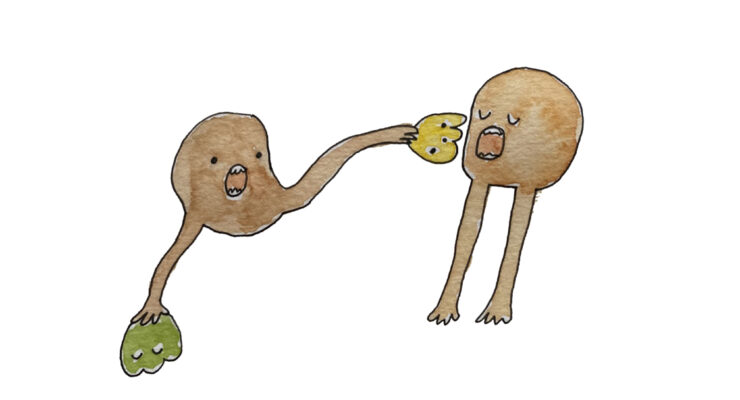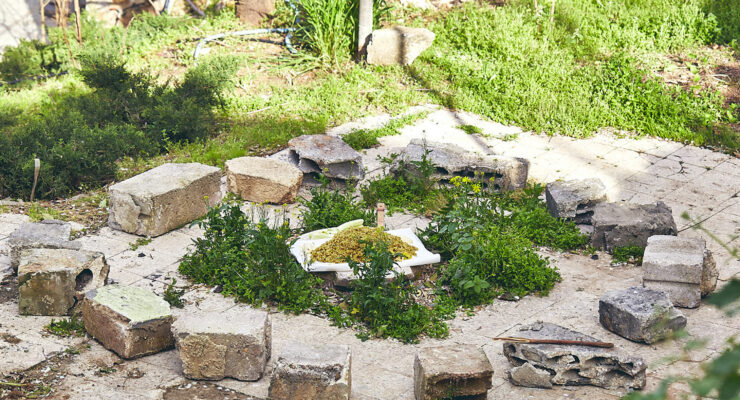“There is a lack of connection from the food design field to the gastronomic world.”
Katinka Versendaal is an experimental food designer. She is deeply interested in what is happening in the world of food as well as in socio-cultural trends, scientific advancements, and their potential impact on the way we eat today and in the future.
Katinka founded her own food design studio, The Eatelier, with the purpose of translating scientific research and technological innovation into the world of food. The Eatelier develops research through an interdisciplinary lens, which then is translated into food and hospitality concepts. The aim is to initiate product innovation and to create compelling culinary experiences for a wide variety of audiences in order to promote the creation of a more delicious, healthy and sustainable future.
What interests you about food & design?
My focus in food design can be found in trying to understand food as a broad spectrum. Food is a complex system in which new scientific findings and technological innovations push ideas forward. It is also shaped by culinary and sociocultural trends, all of which influence the future of what we will consume.
At The Eatelier we have been working on the possible impact of artificial intelligence in expanding the flavor experience within the culinary world. AI can also be applied to personalized preventative healthcare. We are trying to demonstrate that combining these fields and technologies can have numerous benefits for users and providers alike.
Another interesting upcoming development I am currently following is the advancement in human microbiome research. This type of research can revolutionize our notions of nutrition, disease, and behavior. Future breakthroughs in biotechnology and the impact of bacteria on our daily lives may radically transform our relationship with food and even redefine the natural-cultural divide, aiming for the co-existence of both to achieve a healthier body and environment.
The sciences have changed their view on the way we inhabit Earth. This change has been catalyzed by our acknowledgement of living in the so-called Anthropocene era coupled with the recognition of climate change as a direct consequence of unsustainable human activity. As humans today impact over 80% of the terrestrial biosphere, we are directly changing the very bio-system that we require for our own survival. Only recently have we started to realize the importance of the biodiversity around us and inside us: that this biodiversity affects our physical and mental well-being, and eventually our survival as a species.
The culinary world, for example Copenhagen’s culinary powerhouse Noma, has reacted on these planetary crises and exciting innovations in an inspiring and uplifting way. My take is that we could look at the culinary world as we look at Formula-1 race cars. This is the place where big ideas, but also big budgets come together with the drive to innovate. Innovation created in a Formula-1 racer will, over time, extend into your average Volvo station wagon.
To visualize this dynamic for the case of food, cutting-edge culinary innovations and ideas of today will likely be found in our daily supermarket foods several years from now. And just as the winner of a Formula-1 race is not just the pilot, but also the enormous team of engineers, fuel technologists, and financial backers, a potential win in the culinary world also needs support from science, governments, food corporations, and food designers to make change happen.
"Designers come in as specialized professionals, with an unstoppable curiosity and a broad vision of the world surrounding them. After all, designers are the ones that should realize that everything is intertwined (...)"
Do you think designers working with food need to address politics and social issues? And why?
At the base, I feel that the role of designers in any field should be to ignite innovation, to look through established facts and to find new meaningful connections. Designers come in as specialized professionals, with an unstoppable curiosity and a broad vision of the world surrounding them. After all it is designers, if anyone, who should realize that everything is intertwined; touching upon a given subject inevitably leads to a myriad of possible encounters with other subjects.
In today’s world, this is a necessary approach for understanding the planetary crises we are facing today. But there are also exciting new scientific developments, offering new paradigms and potential that can be explored and applied to our daily lives. As a designer, I feel it is my purpose to connect the underlying tendencies of current phenomena with tangible, understandable interventions. The aim is to translate these findings from the theoretical, cold world of techno-scientific research into practical and more relatable additions to everyone’s daily existence.
A designer builds bridges and connects disciplines with each other. Through this, the designer joins their strengths, trying to make sense of larger narratives and searching for a larger picture. The intention is to bring big ideas to life. Ultimately, however, the goal is to create a better world− cultivating a future that is sustainable in every way but is also a pleasant and exciting one to live in.

Chef vs Watson, photo by Ruud Scheerens
What misconceptions about food and design would you like to oppose?
Often I find that there is a lack of connection from the food design field to the gastronomic world. I imagine many designers distance themselves from gastronomy simply because it is not their expertise or they are mainly focusing on the technical or social aspects of what food should be. I can also relate in trying to disassociate work from the huge misconception that food design is the same as food styling. I understand the necessity of the separation of these two but regardless, it should not withhold us from working with the culinary aspects of food.
The connection of my studio to the gastronomic world comes from a belief that it is within humans to strive for beauty, harmony and pleasure, and that is, in my opinion, where the possibility of change lies. Beautiful things bring joy, a beautiful chair brings joy into the house of the owner, a beautiful piece of music brings intense pleasure to the one listening and a beautiful glass of wine has the power to do the same. After all, we as humans are attracted to beauty, in every form; being human is an aesthetic as well as an ontological experience. But that very same music and rhythm when disrupted becomes arrhythmic and chaotic, turning into a distressing presence. A similar feeling occurs when it comes to the flavors of our food. If a dish is well composed, we will deeply enjoy our meal. If not, we will have a hard time introducing the food into our body. Therefore, I firmly believe that any innovation that involves food needs to be a delicious one. If not, we simply won’t eat it.
I propose that when translating research into the world of food, we aim for it to be sustainable, healthy, and delicious.
How do you see the future of food and design?
In my view of the future, consumers will regard food as either nurturing or for dining, and these two approaches will co-exist in the life of each individual. Nurturing foods will be customized, healthy, inexpensive and readily available every day, likely monitored by health-tracking wearable tech. Nurturing food will be made available through various delivery services and elaborate versions of high-tech vending machines. I also imagine an exciting hybridization of the food industry with preventative healthcare, personalized for each individual. On the other end, dining foods will focus on the social and cultural aspects of dining, pairing intense multisensory experiences with more exclusive or more heavily taxed ingredients such as products high in sugar or animal protein.
Additionally, the Digital Age is just beginning to impact our society and humanity as a whole. As technological realities such as the Internet of Things, robotics, and artificial intelligence mature, they will also impact and reshape our food system, from agriculture and logistics to food production and consumption. Nowadays we see a division in high- and low-tech methods of producing food. What binds them is a mutual focus on producing locally, cutting down on CO2 emissions, waste and the use of pesticides, and therefore I imagine that both philosophies of producing will find a way to merge with each other, which will be a necessity in order to be able to feed the growing population with high quality food.
I envision that the role of the chef will also vastly change in the future, becoming a more interdisciplinary profession. As technology significantly lowers the workload in farms and kitchens, chefs will focus on building a bridge between producers and the consumers, being a guide through the food system, educating their guests on products, culture and the food experience while on the other side tweaking production and logistics in their community by creating a demand for products of a specific quality.
The overall food experience will be analyzed and enhanced for an optimal physical and mental health, while being fully sustainable and above all capable of being more delicious than ever.

28 Grams Of Happiness – A Sensorial Food Experience, photo by Ruud Scheerens
What is the best food and design example, and why?
I greatly appreciate IKEA’s take creating consumer products based off hydroponic farming, bringing these production methods into the home and community. Not only does this make a complex technology understandable for the average consumer, it also creates the possibility of being in charge (partially) of growing your own food, which in turn develops a necessary knowledge and awareness of food processes amongst its users. It became an understandable, relatable and tangible product which creates an insight into a much more complex movement within the food system of the future.
—
Read more about Katinka on her:
Instagram: @the_eatelier
Website: www.the-eatelier.com









